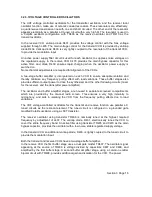
A low c5V regulator operates permanently to supply the microprocessor internal RAM.
The microprocessor derives its power from the +5.2V regulated source via D216, the
remaining logic controlled devices are supplied power via D221. The n5V regulator
has its output boosted to 6 volt by means of the voltage divider R336 and R337 and the diode
D215. Diode D215 is incorporated to provide temperature compensation. The slightly higher
than usual +5.OV supply is required for correct operation of the prescaler integrated circuit
IC402 which also operates off this supply.
When the transceiver is switched off, standby power is only supplied to the microprocessor
and reset circuit, via D219 from the Zener diode regulator formed by D218 and R290. Diode
D216 effectively isolates this standby supply.
At the output of the +9 volt regulator, IC209, are three series pass transistors TR216, TR218
and TR219. TR218 and TR219 are controlled by TR220 which in turned is controlled by the
microprocessor via the latch IC207. When the transceiver is in the receive mode TR220 is
switched off and so is TR219. TR218 derives forward bias via D220 and R297 to ground. With
TR218 switched on the 9 volt regulated supply is connected to the receiver related circuitry.
When the transceiver PTT is activated, the microprocessor switches TR220 on via the Tx
enable on PIN 14 of the latch IC207. This biases TR219 on and in doing so deprives TR218 of
base current, via D220, to turn TR218 off. The transmitter circuitry is powered via TR219 and
the receiver supply is disabled.
To activate the transmitter power amplifier the microprocessor provides a separate control
output, PA enable, via the latch IC207 at PIN 7 to enable transistor TR217. When TR217 is
enabled TR216 is biased on and supplies the transmitter buffer stage TR417 with power. A
timing delay of 40mSec is provided b9V Tx and +9V PA output, to ensure the
synthesizer frequency has settled before the transmitter power amplifier is activated. When
the transmitter is disabled the +9V PA is switched off lOmSec before the +9V Tx supply is
switched off. This also ensures the synthesizer remains on the transmit frequency until the
transmitter power output has ceased.
Transistor TR221 is provided as a transmit inhibit switch and is controlled by the synthesizer
lock detector. If the synthesizer is out-of-lock the base of TR221 is forward biased which
disables the PA enable control to TR217. This ensures that the transmitter is never activated
during an out-of-lock condition.The +23V supply is generated by voltage tripling the +9V
supply using a multivibrator circuit. Two NAND gates from IC200 are configured as a
multivibrator circuit with the frequency of 300kHz set by R200 and C200. The output at PIN 10
of IC200 is a 9 volt peak-to-peak square-wave which is used to alternately switch TR200 and
TR201. These two transistors have different voltage dividers at the base to ensure that only
one transistor will be conducting at any time. The transistors effectively boost the current
output drive of the multivibrator.
The resulting square-wave appearing at the junction of TR200 and TR201 collectors is
coupled to a voltage multiplying rectifier comprising C202, C203, C205, C206, D200, and
D201.
Section 3 Page 18
















































